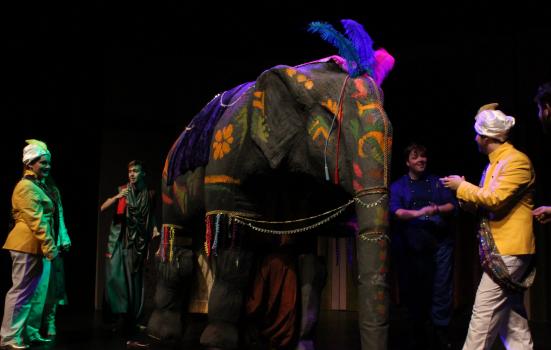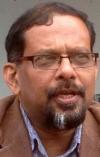New research found audiences in rural Lincolnshire are hungry for culturally diverse theatre and dance, but the provision isn’t there. Arya Madhavan and Sreenath Nair explore the issues.

Alice Dale
The Lincolnshire Diversity in the Arts: Research and Development project aimed to explore ways to develop cultural and artistic diversity in rural England. The main activity was the production and touring of an Edinburgh Fringe award-winning Indian play, ‘Charandas Chor: The Honest Thief’ to selected arts centres around Lincolnshire to study its impact among the audiences.
Rural arts are invisible for the national media and will remain invisible if nothing is done to address this problem
Charandas Chor blended local Lincolnshire and Indian folk dance and music traditions by collaborating with the Lincoln Folk Dance Society and folk singer Frank Kelly. This added a ‘folkal’ flavour to the play.
We conducted interviews with arts venue managers to find out about the local infrastructure and funding situation affecting their programming. We also interviewed a few selected urban-based British Asian theatre and dance companies and artists about their rural experiences, if any, when taking their shows to rural areas.
Key challenges
The project identified six key challenges affecting the rural artistic and cultural diversity in Lincolnshire:
- Distance: This relates to the vastness of the county and the transport issues. Often the last bus to or from a town is at 5pm and most of the theatre, dance and music activities take place after 7pm.
- Demographics: Two main concerns affecting the nature of programming are the age factor and ethnic make-up of the population.
- Infrastructure and marketing: The capabilities of the arts venues to think big when making programming decisions.
- Cultural learning: The opportunities for multicultural interactions open to Lincolnshire communities and how that affects their artistic engagement.
- Funding: Artistic work flows mostly from cities such as London to the disadvantage of rural counties like Lincolnshire. A nationwide artistic policy, such as the Creative Case for Diversity (and associated funding schemes), is also applicable more to urban centres and the realities faced by rural Lincolnshire arts are quite different. The question is one of economic democracy.
- Recognition: Coverage of rural artistic work in the national media is a problem. Rural arts are invisible for the national media and will remain invisible if nothing is done to address this problem.
Reluctance to tour
As expected, Lincolnshire communities have limited experience of watching culturally diverse performances within the county, but we found substantial interest in opportunities to experience and watch performances from diverse cultures.
Jatinder Verma, Artistic Director of Tara Arts, acknowledges that there are a lot of people who are just curious to know about the ‘other’, and this is especially true in rural counties. He says that when you come out of London, the qualitative response of the audience is different. He sees an eagerness among rural audiences to watch culturally diverse theatre, which for him is the real potential of rural touring.
So, the easiest solution for the county’s arts venues is to invite city-based theatre and dance companies to perform in Lincolnshire venues. However, we found from our research that the perceived value of rural artistic work, compared to urban-centred artistic work, is significantly inferior. This potentially influences the decisions of urban theatres to perform in rural venues.
Chris Corner of Kali Theatre says that attracting the interest of top actors to work in a rural play can be challenging because of the inferior status attached to rural performances. Casting celebrities to perform in rural shows is totally out of the question because rural shows would not attract press reviews or media attraction. This then goes in a spiral.
Since the rural shows can only recruit third or second-level cast and crew, and to some extent this applies to playwrights who write plays for rural productions, this adversely impacts upon the quality of a rural production. Since the quality of the rural shows is inherently compromised, they fail to ever tour in urban centres. All this means that rural productions miss out on good press reviews and media coverage.
Corner also adds that without funding support from Arts Council England (ACE) and subsidised ticket prices from a rural touring network, Kali’s co-production with Black Country Touring and Arts Alive, ‘Big Fat Cowpat Wedding’, would not have been successful.
Our recommendations
Since a good proportion of our audiences were retired people, who have the time and money to engage in the arts, more thinking needs to be invested in engaging them. Availability of transport to and from arts venues could potentially alienate them from artistic engagement, so curating daytime programmes is one recommendation.
We also recommend specific programmes for cultural learning focusing on young people in schools.
It would also be helpful for ACE to introduce a contractual clause for its urban national portfolio organisatoins to conduct rural touring on a regular basis.
We would argue for ring-fenced funding support from ACE to develop cultural and artistic diversity in Lincolnshire. Such funding schemes would help to initiate small-scale and continuous multi-cultural activities in the county. These could be in conventional, town-based arts venues or in village halls, church halls and local schools. To enhance better urban-rural interaction in diverse artistic activities, specific projects could be initiated to that effect.
Arya Madhavan and Sreenath Nair are Senior Lecturers in the School of Fine and Performing Arts at the University of Lincoln.
www.lincoln.ac.uk





